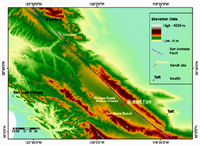Multi-cycle
Rupture History of the San Andreas Fault in the Carrizo Plain
Bidart Fan SIte
Home
Project Summary
Data on the rupture history of the SAF form the basis of numerous models
of fault behavior and seismic hazard. Models of fault behavior range from
simple, deterministic systems such as the time-predictable and slip predictable
models of Shimazaki and Nakata (1980), to complex, non-linear, and/or
chaotic systems that can be described as a group, but cannot be individually
predicted (Liu, 2003). The
high slip rate, short recurrence interval, great length and accessibility
of the SAF make it the best target in the U.S. (and perhaps the world)
for observational testing of fault behavior models. Paleoseismic data
are essential for such testing, because they are the only type of observations
that span multiple earthquake cycles.
The Carrizo
Plain is one of the best places to study the rupture history of the SAF
because it has a proven paleoseismic record with excellent slip rate and
slip per event measurements, and the potential to significantly enlarge
the data set by increasing the length of the earthquake record. The Carrizo
Plain has been one of the most productive sections of the SAF for paleoseismic
research, yielding multiple slip rates from different time intervals at
Wallace Creek in agreement with geodetic measurements; slip per event
measurements for the last 6 ruptures; and well-constrained dates of the
last 5 major earthquakes at the Bidart Fan and Phelan Creeks . The Bidart
Fan site in the Carrizo Plain has the potential to produce a multi-cycle
rupture history spanning at least 3000 years, with a minimum of 10 surface
ruptures. We propose to exploit this record in the characterization of
the rupture history of the south-central San Andreas Fault. The record
will be especially valuable because it can be combined with existing slip
rates, slip per event data, and future measurements of slip per event
at the Van Matre Ranch (VMR) site and the nearby Wallace Creek offset
site of Sieh, Liu, and associates. Our proposed research at the Bidart
Fan should allow us to double the temporal record of surface ruptures
in the Carrizo Plain and provide a third major paleoseismic site on the
San Andreas fault for developing and testing models of fault behavior.
Bottom line: The proposed research will provide additional insights on the magnitude and dates of past earthquakes in the Carrizo Plain and thereby help to assess the potential magnitude, location, and date of future damaging earthquakes.
